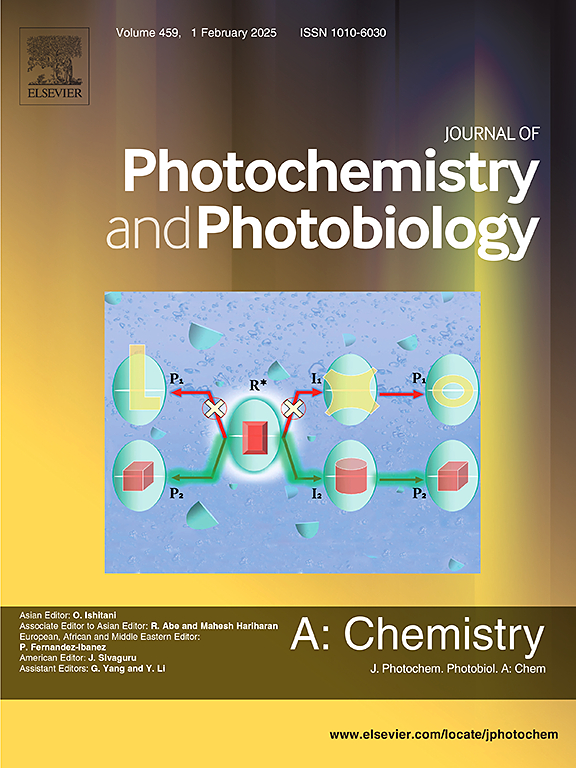机器学习和 DFT 辅助分析苯并二噻吩基有机染料在光伏领域的可能应用
IF 4.1
3区 化学
Q2 CHEMISTRY, PHYSICAL
Journal of Photochemistry and Photobiology A-chemistry
Pub Date : 2024-11-13
DOI:10.1016/j.jphotochem.2024.116157
引用次数: 0
摘要
我们提出了一种将机器学习(ML)、密度泛函理论(DFT)和分子描述符分析相结合的协同方法,用于设计基于苯并二噻吩(BDT)的高性能发色团。我们从文献中汇编了一个包含 366 个 BDT 结合分子的数据集,并使用 Python 编程语言设计了它们的分子描述符。线性回归模型和随机森林回归模型在预测它们的激子结合能(Eb)方面取得了最佳结果,其 R 平方(R2)值分别为 0.87 和 0.94。他们的 DFT 计算提供了更多特征,包括分子电荷。他们的 ML 模型还显示,Eb 值是预测其光伏(PV)性能的关键因素,因为较低的 Eb 值可以促进有效的电荷载流子分离。为此,在回归分析过程中,它们的氢键受体(HBA)和拓扑极性表面积(TPSA)成为关键的描述因子。DFT 验证显示,它们的分子电荷差异微乎其微,这表明它们的电子供体/受体分子对其发色团性质有重大影响。目前的研究工作有助于通过先进的计算工具有效筛选出适合光伏应用的有机发色团。本文章由计算机程序翻译,如有差异,请以英文原文为准。
A machine learning and DFT assisted analysis of benzodithiophene based organic dyes for possible photovoltaic applications
We present a synergistic approach to combine Machine Learning (ML), Density Functional Theory (DFT), and molecular descriptor analysis for designing high-performance benzodithiophene (BDT) based chromophores. A dataset of 366 BDT incorporated moieties is compiled from literature while their molecular descriptors are designed by using Python programming language. Linear and Random Forest Regression models produces best results to predict their exciton binding energy (Eb) with their R-Squared (R2) value 0.87 and 0.94 respectively. Their DFT calculations provides additional features, including molecular charges. Their ML models also reveals that their Eb values are a crucial predictor for their photovoltaic (PV) performance as its lower value could facilitate efficient charge carrier separation. For this, their hydrogen bond acceptors (HBA) and topological polar surface area (TPSA) emerges as key descriptors during their regression analysis. Their DFT validation shows negligible differences in their molecular charges to suggest their electron donor/acceptor moieties can significantly impact their chromophore nature. The current research work is helpful for efficiently screening the suitability of organic chromophores for their PV applications through advanced computational tools.
求助全文
通过发布文献求助,成功后即可免费获取论文全文。
去求助
来源期刊
CiteScore
7.90
自引率
7.00%
发文量
580
审稿时长
48 days
期刊介绍:
JPPA publishes the results of fundamental studies on all aspects of chemical phenomena induced by interactions between light and molecules/matter of all kinds.
All systems capable of being described at the molecular or integrated multimolecular level are appropriate for the journal. This includes all molecular chemical species as well as biomolecular, supramolecular, polymer and other macromolecular systems, as well as solid state photochemistry. In addition, the journal publishes studies of semiconductor and other photoactive organic and inorganic materials, photocatalysis (organic, inorganic, supramolecular and superconductor).
The scope includes condensed and gas phase photochemistry, as well as synchrotron radiation chemistry. A broad range of processes and techniques in photochemistry are covered such as light induced energy, electron and proton transfer; nonlinear photochemical behavior; mechanistic investigation of photochemical reactions and identification of the products of photochemical reactions; quantum yield determinations and measurements of rate constants for primary and secondary photochemical processes; steady-state and time-resolved emission, ultrafast spectroscopic methods, single molecule spectroscopy, time resolved X-ray diffraction, luminescence microscopy, and scattering spectroscopy applied to photochemistry. Papers in emerging and applied areas such as luminescent sensors, electroluminescence, solar energy conversion, atmospheric photochemistry, environmental remediation, and related photocatalytic chemistry are also welcome.

 求助内容:
求助内容: 应助结果提醒方式:
应助结果提醒方式:


